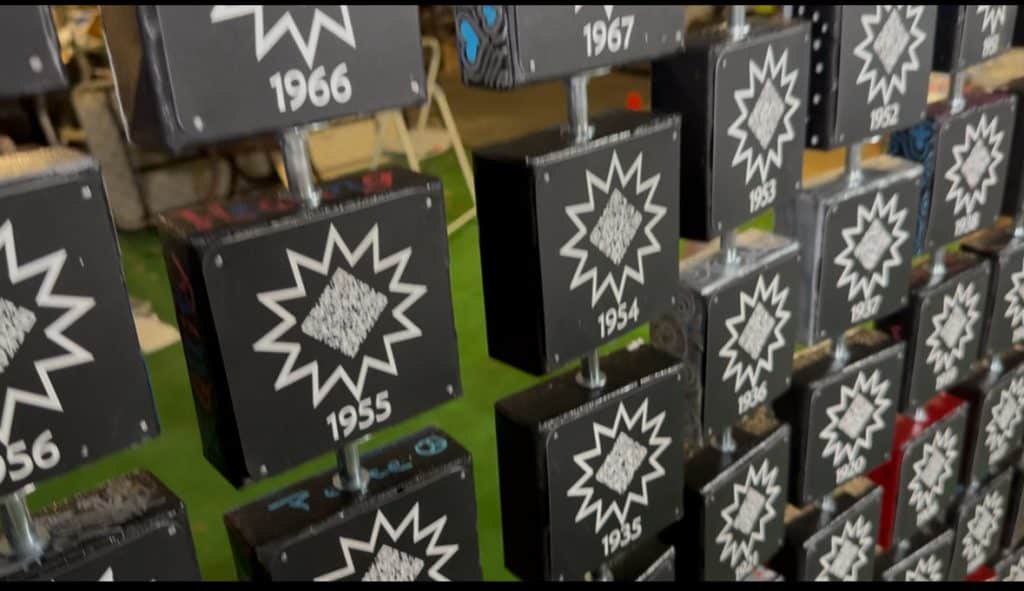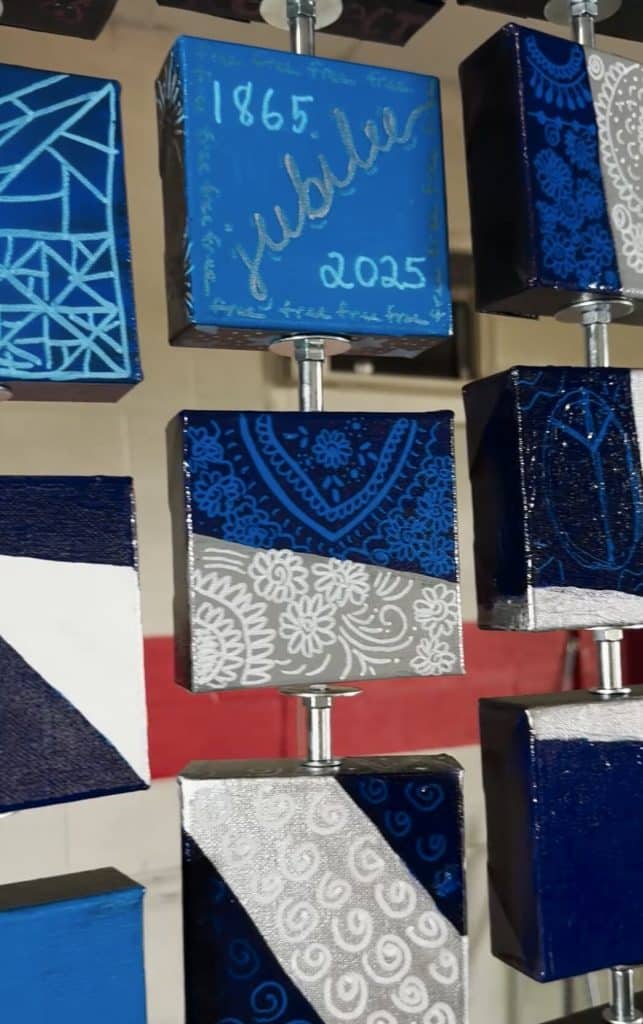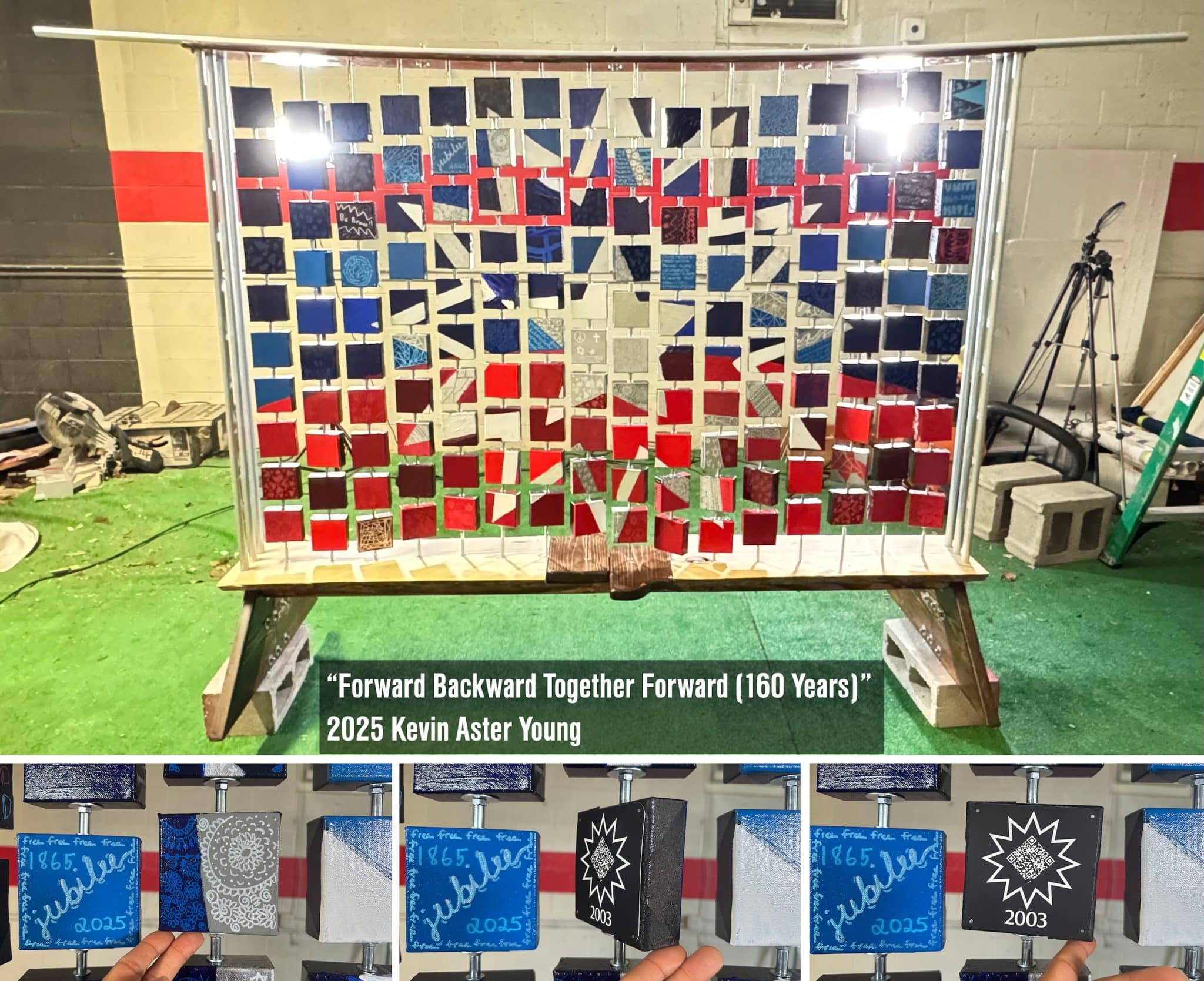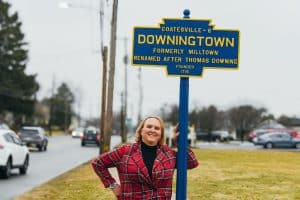“Forward Backward Together Forward (160 Years)” will present the pendulum of Civil Rights in American history to the Bucks County community this weekend.
This collaborative art work, created by Kevin Aster Young, an artist living in New Hope, will be unveiled Saturday at the Mercer Museum Juneteenth Celebration from 12 p.m. to 3 p.m.
Young, who also founded the Bucks County Anti-Racism Coalition in 2020, made the piece based on the Juneteenth Flag. Each of the tiles, placed on spindles, correlates to a year of Black history, and each has a QR code on the back that links to an informative article about that respective year. Starting from 1865, which is the first tile on the bottom left, the years travel from the left to the right end, up one row, from the right end to the left end, and up one row again – like a zigzag. This design is purposeful in its relation to the title of the piece.

Young’s piece is timely, given that 2025 is a contentious year in racial politics. Young said he believes racial progress is currently being challenged through attacks on diversity, equity, and inclusion, or DEI, along with an effort to minimize the contributions of Black Americans throughout history.
“The title alludes to the fact that this is not the first time this has happened in our history,” Young said. “It serves as a reminder that the struggle for racial progress is not a steady climb toward liberation, but often it is a reiteration of steps previously taken, and it can move backward before it moves forward again.”
This rollback of progress is not subtle, Young believes. On April 10, the Safeguard American Voter Eligibility Act, which would require all Americans to prove their citizenship status to be eligible to vote, was passed through the U.S. House – with local Rep. Brian Fitzpatrick voting for it. According to the Campaign Legal Center, more than 21 million Americans, a significant portion being people of color, are unable to access the documents that would be required to vote under this act. ProPublica also recently reported on the dramatic reshaping of the Office for Civil Rights under the second Trump Administration.
“It serves as a reminder that the struggle for racial progress is not a steady climb toward liberation, but often it is a reiteration of steps previously taken, and it can move backward before it moves forward again.” – Kevin Aster Young
“We’re also seeing that there’s this push to reframe white Americans as oppressed rather than Black Americans. We’re seeing that there is an increased effort to diminish the status of non-white Americans, and Black and brown people,” Young said. “Art has always been a way to tell the story and expose injustice.”

In prior years, Young would start painting a canvas and bring it to the event, along with necessary art supplies, where attendees would contribute to it in real time. But because this year’s Juneteenth marks the 160th anniversary, and the political climate is more heated than ever, Young went for a different approach. He divided up the piece into one hundred sixty different tiles, and sent ten tiles to sixteen different community organizations and faith-based institutions for them to contribute. Young provided the participants with different shaded paints of red, white, blue, and gray, and gave general instructions so as to represent the Juneteenth flag.
Of the community organizations and faith-based institutions involved were the African American Museum of Bucks County, BC Cares Educational Foundation, Bristol Riverside Theater in collaboration with No Longer Bound, Bucks County Community College, Immigrant Rights Action, Mercer Museum and Fonthill Castle, Michener Art Museum, Newtown Arts Company, NOVA Bucks, the Peace Center, Pebble Hill Interfaith Church, Planned Parenthood’s Rainbow Room, Southampton Friends Meeting, Temple Judea of Bucks County, YWCA Bucks County, and the Zubaida Foundation.
“I had all these different organizations, people of all ages, races, genders, orientations, religious backgrounds, have a hand in making this what it is,” Young said. “I hope the takeaway is that diversity should be valued.”
Young believes this year’s piece has a sense of motion because the tiles are staggered slightly forward and slightly back, and have space in between them.
“Unlike the previous works that were on canvas, this kind of breathes,” Young said. “It has a sense of openness that I am really happy with.”
As for now, Saturday will be the only day the art piece is available for public viewing, though Young is currently looking for a permanent home for his timeless representation of American history.







